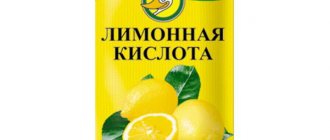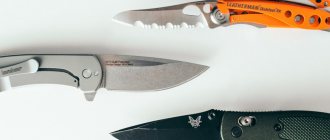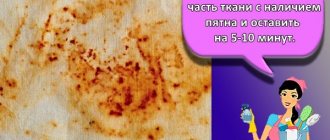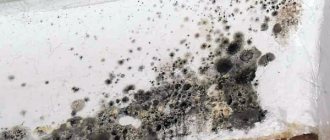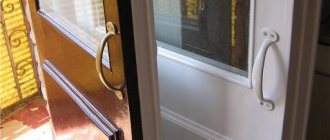Metal products are susceptible to corrosion. The process occurs at the molecular level - this is the nature of the metal. A blade that is improperly cared for or stored is prone to rust. It has many negative consequences. Any owner of a sharp-nosed product should have knowledge of how to remove rust from a knife.
Small areas of corrosion on the knives.
Anti-corrosion agent with zinc
It is sold in spray bottles and has no worse effect on corrosion than acid solutions.
- Before treating with the product, walk over the surface of the knife with iron wool or fine-grained sandpaper.
- Rinse with running water.
- Degrease with an alcohol solution. This creates an optimal environment for the interaction of zinc with metal, during which rust is removed from the knife.
- Use plastic or glass containers for long-term soaking if the surface of the blade is deeply damaged.
- For small stains, apply two coats with a spray bottle (you can use a brush). The first layer is a primer. It dries in 5 – 10 minutes. The second one is applied next.
- Remains of rust from the knife are removed with a scraper.
Measures to prevent corrosion
They say that in order for a knife blade not to rust, it must be used more often. This expression is not without meaning. A knife that is in constant use is regularly wiped, processed, and is in plain sight. Meanwhile, a stored and not used copy is no less at risk of damage by corrosion. If you forget about it for a while and do not treat and clean the metal parts, it will almost certainly rust. The fact is that moisture is found everywhere, including in the air. Gradually settling on the surface of the blade, it will inevitably lead to the process of iron oxidation. Protective compounds, by the way, cannot retain their qualities indefinitely; they must be periodically removed, the knife cleaned and reapplied.
Many owners of professional and hunting knives avoid preventative oil treatment. It is believed that oil can enter into additional interactions with various substances and harm steel. In this case, wax has proven itself to be a more reliable remedy. In addition, a knife that is used occasionally should not be stored in a case or sheath. Any unfavorable conditions, primarily air humidity, in such a cramped space will worsen, and the damage process will accelerate. In addition, you can miss the beginning of the process by simply not seeing it. It is better to sheath the knife when it comes time to take it with you on a trip, hunting, etc.
With the right approach and sufficient attention to the subject, corrosion can be avoided. It is better to spend time preventing a problem than fighting it. Removing rust and preventing its occurrence is a painstaking process that requires regularity. However, perhaps this is one of the few cases when caring for a thing is enjoyable and has a calming effect. The smooth, polished surface of a knife is the owner’s best reward for his efforts.
How to care so that the knife does not rust
How to prevent a knife from rusting is a completely natural question. And there is only one answer – proper care and timely prevention.
- It doesn’t matter what kind of knife you have - kitchen, hunting, decorative or homemade, it is necessary to periodically apply a layer of special wax to it. Collectible instruments that are not used at all are especially susceptible to corrosion.
- If the knife is intended for personal purposes, then try to use it as often as possible - this way the tool will be processed naturally.
- After routine cleaning, be sure to wipe the knives dry and treat them with acetone or alcohol.
If a knife rusts in your house, what to do and how we described it in the article. With the help of our tips, you can restore the original shine and beauty of your cutlery quickly and easily. But it’s better not to allow corrosion into your kitchen, but to take care of household items in a timely manner. Follow preventive measures and you will never see destructive rust in your home.
Chemical methods of removal
Chemical methods for removing rust are among the most effective. Below we will discuss the most common options for cleaning surfaces from corrosion.
Sulfuric or hydrochloric acid
These anti-rust products for metal are used in combination with inhibitors. To remove traces of rust, you will need an aqueous solution of acid and methenamine as an inhibitor. Without methenamine, it is unacceptable to use such aggressive reagents - the metal can be destroyed under the influence of acids, and the product will be damaged.
To remove corrosion from the surface of small metal parts, they can be immersed in a mixture of a 5% solution of hydrochloric or sulfuric acid and methenamine at the rate of 500 mg per 1 liter of water. Large objects are treated with the same composition using a wide brush. You can remove rust stains from a white fabric item using 2% hydrochloric acid. To do this, immerse the product in an acid solution and leave until the red stain completely disappears. Then the item is removed and rinsed in a weak solution of ammonia. To prepare it, take 3 tablespoons of alcohol per 1 liter of water.
Potato tops can be used as an inhibitor. To prepare the composition, you need to fill a three-liter container halfway with tops and add hydrochloric acid so that it covers the stems. The contents of the jar are constantly stirred for 20 minutes, then the liquid is drained and the damaged surfaces are treated.
Oxalic acid
When working with oxalic acid, you must follow safety precautions - use safety glasses and thick rubber gloves. It is also advisable to use a respirator, since the vapors of this substance are very toxic. To begin with, the rusted part is washed with warm water and detergent and dried thoroughly. Dissolve 6 teaspoons of oxalic acid in 300 ml of water and immerse a rusty object in the resulting solution for half an hour. The remaining plaque is removed with a brush. After processing, the item is thoroughly washed and dried.
Phosphoric acid
Using a metal rust remover, you can turn a layer of corrosion into a thick coating. To do this, use acid with a concentration of 15 or 30%. It is applied to damaged metal products using a spray and left in the open air until completely dry.
For greater efficiency, 1 liter of phosphoric acid must be mixed with 5 ml of butanol and 15 ml of tartaric acid. As a result of processing, a durable protective film of iron phosphate is formed.
Lactic acid
If the item is severely corroded, you can treat it with a mixture of 50 ml of lactic acid and 100 g of liquid paraffin or petroleum jelly. Under the influence of acid, rust turns into salt, which dissolves well in paraffin. Next, wipe the cleaned surface with a napkin soaked in Vaseline oil.
Zinc chloride
In 100 ml of water, 5 g of this substance is mixed with 0.5 g of cream of tartar. Under the influence of the acidic environment created by zinc chloride, rust will easily dissolve.
Lemon acid
Citric acid powder is poured into a plastic container and filled with hot water. The rusted product is immersed in the resulting solution and left overnight. If the solution is prepared correctly, the liquid will begin to bubble and hiss when it comes into contact with the rusted surface. In the morning, the product is removed from the solution, washed with clean running water and dried thoroughly.
Cleaning knives with chemical reagents
Well, after trying some of the methods from popular recommendations, and if the result was not achieved, you can resort to the help of potent reagents. Most often, such methods are resorted to in case of severe corrosion damage.
These methods can also be called partly folk, but they can be quite effective. Such methods are much more aggressive and the result can be seen in a short period of time.
It is better to use them with rubber gloves and try not to inhale the fumes released. Let's try to describe three ways:
- Zinc chloride, potassium hydrogen tartrate. To perform this procedure, you will need 100 ml. water in which you need to dissolve 0.5 grams of potassium hydrogen tartrate and 5 grams of zinc chloride. When the reaction begins, lower the blade there and, as with the method using Alka Seltzer, wait for the reaction to complete, but in this case the knife will have to wait about 2-3 hours. Once the reaction is complete, remove the wedge and wipe dry with a cloth.
- C hydrochloric acid. When using such strong acids, by the way, instead of hydrochloric acid, you can use sulfuric acid. You need to be especially careful and attentive; special inhibitors are used with them to reduce the destructive effect on the metal. Otherwise, the blade will “eat” up to the hilt. The solution should be 5% acid and methenamine (0.5 grams per liter). Then the knife is treated with a brush or rag well soaked in this mixture.
- And Lka seltzer. The drug for headaches after a stormy feast turns out to have other useful chemical properties. You will need 5 tablets of this drug. We lower them into the container, and then fill them with water, dip the rusty blade into it and keep it there until bubbles appear. As soon as the boiling process is over, remove it and remove any remaining dirt with a soft cloth.
Removing rust from a knife using chemicals.
Working with such chemical compounds yourself can be dangerous. It is unknown what reaction can occur if the proportions are mixed incorrectly. And where to get some of the reagents, you may not be able to find them in the public domain.
For this, various manufacturers of household chemicals have developed a whole line of rust removers.
Rough cleaning of a knife from rust
A rusty blade can be sanded
Before starting work, you should assess the degree of damage: how much the steel has oxidized and what is the surface area affected by rust. Rough cleaning makes sense when there is severe oxidation. Using tools you can only get rid of the top layer of rust. Remaining deposits will have to be removed using cleaning agents.
Mechanical work is carried out according to the general scheme:
First, the oxidized metal must be prepared and softened. To do this, use non-aggressive means, for example, kerosene or white vinegar. The reagent is poured into a mug and a rusty knife is kept in it for 10 - 15 minutes. Then you can start cleaning. If the layer of dirt is thick enough, you will have to use a chisel with a small hammer or similar tools. You should beat it carefully, trying not to damage the metal. Any remaining oxidation particles should be sanded off with sandpaper. A metal brush, sold in a hardware supermarket, is also suitable for removal. It is not recommended to use sandpaper if the deformed layer of iron is too thin
Such cleaning inevitably causes scratches, which in turn accelerates corrosion processes. If there is severe contamination by deposits, electronic devices will help, the hydrolysis method is the combined use of a solution with reagents and a device that passes current through it. At the last stage, it is important to ensure that there is no dust or particles of abraded deposits. If they remain, corrosion will appear and grow again.
If done correctly, the knife will look like new.
Bathtub cleaning
Sometimes it is necessary to remove rust from non-metallic objects that are not very convenient to process using the methods listed above. Rusty stains may form on the surface of plumbing products. To clean the bathtub from rust, you can use a wide range of special products, which are currently widely represented on the Russian market (Sanox, Phenolux, Akrilan). Using a brush or sponge, apply the product to the surface and leave for 5 minutes, sometimes longer. Then rinse off while scrubbing the bath with a brush.
There are also traditional means of removing rust in the bathroom at home. Simple ingredients such as soda, salt, and vinegar can act as a rust remover. One method recommends applying equal proportions of soda ash and baking soda to the surface of the bathtub, then spraying it with a mixture of bleach and table vinegar. After 30 minutes, clean with a sponge and rinse with water.
Another method requires adding salt to acetic acid and heating it all in the microwave. Then moisten a napkin with this mixture and wipe the bath. After 20 minutes, wash off with water. There is also a method in which ammonia and hydrogen peroxide are mixed in a 2:1 ratio and then the resulting solution is applied to the enamel surface for 20 minutes and then washed off.
To clean the toilet from rust, use industrial products specially designed for this problem: Komet, Sorti, Pemolux, Sanita. These are abrasive products. You can use alkali-based products: Dosya and Domestos. These substances do not injure the surface of the toilet bowl and do not require much physical effort: after applying the product to the area, leave it for 15-20 minutes and then wash it off. Comet and toilet duck contain acids.
Traditional removal methods
There are a number of methods on how to clean rust from a knife using available products at home. In addition to being economical, these methods allow you to avoid damaging the appearance of products by resorting to sandpaper and abrasive brushes.
Potato
The use of this product for cleaning steel is due to the oxalic acid it contains, the effect of which can be enhanced with laundry soap, soda or salt.
- To achieve the result, cut the potato into two parts, rub soap on the cut and place it on the problem area.
- The damaged knife must be left in this state for at least half an hour, after which the rust will easily come off.
Tip: if the potato is saturated with rust, but the contamination is not completely removed, refresh the cut of the tuber and reapply.
Onion
Another vegetable whose chemical composition is worth considering if you don’t know how to remove rust from a knife. Onions contain a considerable amount of organic acids, which actively break down corrosive growth.
The principle of application is the same as with potatoes.
Vinegar and lemon juice
If old problem areas are identified, the question of how to soak off the rust becomes much more pressing. Vinegar is considered one of the most accessible neutralizers - it literally dissolves the defective formation, transforming it into a paste.
To remove rust with vinegar, soak it for several hours. If it is not possible to clean the tool in this way due to its large size, then either fill the knife with the substance and leave it for a day, or wrap it in a well-soaked cloth for a while.
When using lemon (or lime), before pouring the juice over the surface, it is recommended to sprinkle it with a decent amount of salt. When the dirt is gone, it is best to clean the remaining residue from the blade with citrus peel.
Tip: on the surface of stainless steel, which is still corroded, you can initially “walk” with a delicate nail file, and then wipe it with lemon juice.
Tomato paste + sauce + ketchup
Processed tomatoes contain much more acids than fresh vegetables. It is for this reason that tomato paste is an excellent assistant in the fight for the former shine of knives.
It is enough to apply a couple of drops of the product to the problem area and rub it with your hand (do the manipulations with gloves), and after just a quarter of an hour you will be able to observe a positive result.
Sauces and ketchups containing tomato paste have the same properties, so for a better cleaning effect you can mix several types of product into a homogeneous mass in equal quantities.
Advice: if you have expired sauce lying around in the refrigerator, do not rush to throw it away, leave it as a means to combat rust.
Lactic acid + petroleum jelly
A mix of these products will help remove rust from any steel (including Damascus) in a short time.
It is enough to mix one part of lactic acid (50 ml) with two parts of Vaseline and apply to the affected area. Corrosion will quickly corrode and be removed along with the oil coating.
Tip: if you don't have Vaseline, you can just as easily use paraffin or wax.
Baking soda
A unique powder that can clean absolutely any stain. Using soda paste, you can easily get rid of not only rusty deposits, but also blackness on antique knives. Just add a few drops of water to a bowl of powder, stir, and then apply the resulting mixture to the product.
Carbonated drinks
Coca-Cola or any other soda can remove fresh rust formations. You need to soak the knife in the drink for a couple of hours, and then wipe it dry with a cloth, removing softened particles of damaged metal.
Removing rust using electrolysis
The method is effective, but dangerous. Therefore, it should be used only in the most necessary cases, if rust cannot be dealt with using folk remedies and special chemicals.
To remove corrosion, proceed as follows:
- Fill a plastic container with warm water.
- Add 2 tbsp. l. soda or salt.
- Get a car battery charger.
- Attach a metal plate to one wire, and a corroded object to the other.
- Place both ends in the container and turn on the device for half an hour, setting the current to 4–6 amperes.
- Remove any remaining rust with a brush or sponge.
Where does rust start?
During daily use, the knife blade is exposed to water. For example, a knife for a hunter comes into contact with the blood of a killed animal and various chemical reagents. Therefore, experienced hunters focus on the main rule - first clean the knife and then sheath it.
If you ignore this principle, the owner will provoke the formation of contaminants that negatively affect the blade and additional elements of the product. After removing the dirty blade, the remains of harmful elements will remain inside, multiplying and completing the job started after returning the knife to the case.
A similar situation applies to kitchen knives. If, after use, you leave the utensil with food residues, then the blade will not only become dull, but also oxidize. Thus, unconscious harm is caused to the health of household members.
Cleaning using folk remedies
If you don’t want to struggle with mechanical rust removal, you can use proven folk methods.
Acetic acid
It is better to use 70% acetic acid. Then the result will be more noticeable. If there is little rust, then sometimes regular 9% table vinegar is enough.
To remove corrosion and “time deposits” you need to follow a few simple steps:
- Pour the required amount of acetic acid into a deep container so that it completely covers the instrument.
Healthy! For this processing, it is best to use a plastic container that closes tightly with a lid.
- Place rusty products in a container and cover everything with a lid.
Screenshot of a video from the ARS Pro channel https://www.youtube.com/watch?v=0E6kY9JMggE
Tools should be left in this condition for several days (the duration of cleaning depends on the intensity of the contamination). After this you can open the lid. The peeling rust will be clearly visible underneath.
Important! After cleaning the parts with vinegar, you need to rinse the tools in a baking soda solution to remove the acidity
Citric acid and hydrogen peroxide
For 100 ml of water you will need 20 g of citric acid (two packs) and 10-15 ml of peroxide. If you add more citric acid, you will get a more concentrated composition, which is also acceptable.
Healthy! Citric acid without hydrogen peroxide is also effective against old rust.
Screenshot of a video from the OnlyKit channel. https://www.youtube.com/watch?v=0kKy9fpvo1Y
The cleaning procedure is very simple. First, mix the composition in a container and place the tool in it. After this, we leave everything to soak for 24 hours (however, the first result is visible after just a few hours). The liquid becomes dark and the amount of rust decreases.
The main advantage of this method is that the used solution does not need to be thrown away. It is enough to strain it through cheesecloth or cotton cloth and use it for other old tools.
Screenshot of a video from the OnlyKit channel. https://www.youtube.com/watch?v=0kKy9fpvo1YHealthy! It is advisable to purchase hydrogen peroxide with a high percentage of the active substance. However, 3% peroxide will be enough to remove rust.
Coca-Cola
This carbonated drink is used by many to clean stoves, kettle deposits, and much more. Coca-Cola is also suitable for small tools, screws, and dies. Cleaning is very simple:
- Pour Cola into a container (for example, a glass jar).
Screenshot of a video from the channel Man with Hands https://www.youtube.com/watch?v=vqZDA7SmMQE
- Place the rusted part in the liquid.
- Close the lid.
- Leave it for a day.
Lemons
To clean, just cut a few lemons and squeeze the juice into a container. After that, we lower the part into it. All that remains is to close the container with a lid and wait a day.
If we talk about the effectiveness of lemon and Coca-Cola, then the carbonated drink will only cope with very fresh rust. Lemon is the most effective, but getting enough lemon juice to clean a hammer or other large tool can cost a lot of money. It is much cheaper to buy citric acid.
Screenshot of a video from the channel Man with Hands https://www.youtube.com/watch?v=vqZDA7SmMQE
Sulfuric acid
This substance copes well with oxidation. However, before using such a product, you need to dissolve sulfuric acid in water so that its density is 1.15 g/cm3
This is an important condition, since with an increased concentration of the substance, not only corrosion will be destroyed, but also the metal itself
Important! You can work with sulfuric acid only in protective gloves, goggles and a respirator. After preparing the solution of the required density, it is enough to dip the part in it for 20-30 minutes
After this, you need to thoroughly clean and rinse the instrument.
After preparing the solution of the required density, it is enough to dip the part in it for 20-30 minutes. After this, you need to thoroughly clean and rinse the instrument.
Folk remedies for rust
Folk remedies for rust on a knife
You can clean the knife from traces of rust using unprofessional means. Home methods are sometimes simple and effective:
- A mixture of lemon juice and vinegar in a ratio of 50:50. The product acts against stains and thin layers of rust. Vinegar is applied to the surface of the knife and washed off after 2 hours. The instrument must then be wiped dry with a cloth.
- Baking soda is used to soften the metal. It is diluted with water and applied to the knife in the form of a thick paste, reminiscent of sour cream. After holding for half an hour, the product is removed, and the instrument is subjected to thorough mechanical processing. Baking soda will make the dirt come off faster.
- Traces of oxidation can be removed with regular raw potatoes, thanks to the oxalic acid contained in the vegetable. The available material, cut in half, is applied to the rust stain for 15 minutes. Then the instrument to be cleaned must be wiped dry with a rag.
- A well-known home method is to use Coca-Cola, the anti-corrosion properties of which are widely promoted on the Internet. It's all about phosphoric acid, which is contained in many sodas. Coca-Cola is no exception. It is enough to leave the instrument in a glass of drink overnight. Soda perfectly dissolves rust, but after treatment the blade must be washed, cleaned with a toothbrush and wiped with a dry cloth.
- Old rust is coated with salt with the addition of citric acid. After 5 minutes, the surface needs to be sanded with the core of a juicy young potato. It is important that the salt crystals dissolve and do not scratch the surface. The entire procedure is repeated 2-3 times until the rust is completely gone.
Traditional methods are generally ineffective when the blade is covered with a large layer of rust. In these situations, it is better to use specialized tools.
Sometimes the corrosion process can be stopped at the very beginning. If stains have only recently begun to form, you can simply wipe them off with an eraser.
The process of removing rust from metal at home.
After cleaning the metal objects from loose rust with a brush, I placed them in a plastic tray. It took 2.5 liters of water to cover them completely. For this amount I poured 200 grams of lemon. Then I stirred it until completely dissolved, immersed our “test subjects” again and left the solution to “work.” I placed the second sleeve vertically specifically so that later I could show the result as in a toothpaste advertisement: “we will spread the right side of the egg with regular toothpaste, and the left side .....”))).
The citric acid solution gradually eats away the rust layer by layer. To ensure access of the acid to subsequent layers, after 2-3 hours I take out all the objects and clean off the corroded layers with a wire brush. It takes no more than 5 minutes, but the result is much better. Then every hour I repeat this procedure 3-4 more times. The photo shows cleaning the ax after 2 hours in the solution. As you can see, the effect of the solution for removing rust from metal is already visible to the naked eye.
It is necessary to clean off the corroded layer only for deeply ingrained rust. The key lay in the open air for several months, so the rust did not have time to eat as deeply as into the ax or the sleeve. It only took him 2 hours to completely get rid of the rust. The result can be seen in the photo. I took out the key, and the rest of the items continued to lie in the solution.
After a day, the transparent solution accumulated a large amount of corroded rust and became very cloudy. Now we clean all the items again with a metal brush from rust residues, wash them in a solution and look at the result.
Non-standard solutions for removing corrosion from metal
Treating a knife against rust is possible not only with potato juice and lemon. In this difficult task, soda, anti-hangover pills and even ketchup come to the rescue. These methods are resorted to if natural components have not eliminated corrosion 100%.
Always Coca-Cola
This carbonated drink contains phosphoric acid, so doctors do not recommend drinking it. It is she who neutralizes the red plaque. Pour the soda into a glass container and plunge the knife into it. Leave for eight hours and then brush with a toothbrush.
If corrosion has formed on a pipe or other large surface, then spray the cola with a spray bottle or using a sponge. Wait until the plaque softens and brush off with a brush or cling foil.
Note: metal products are treated not only with the popular drink, but also with other low-priced sodas. It is important that phosphoric acid is listed on the label.
Tomatoes against metal corrosion
If you accidentally find expired ketchup or tomato juice in the refrigerator, you should not dispose of the product. Experienced housewives and hunters advise using it to clean knives. Treat the surface of the blade with ketchup or juice and set aside for 30 minutes. remove rust with product residues along with rusty deposits. Then, rinse the knife under warm running water.
Anti-hangover and anti-rust remedies
Preparations like Alka-Seltzer will help restore the shine and cleanliness of metal or aluminum surfaces. Add five tablets to 1 liter of water. Load the products into the container along with the solution. Remove after 20 minutes and brush with a toothbrush. Then, rinse under running water.
How to protect a blade from corrosion: prevention
Always dry your knife after use
To prevent the knife from becoming rusty, you need to be careful when storing it. The oxidation process occurs as a result of exposure to moisture on the metal, as well as due to some trace elements remaining on the surface of the blade.
To reduce the rate of deformation, it is necessary to ensure careful operation:
After use, the blade should be washed and dried with a towel.
Firstly, this will remove food residues on which microbes settle, accelerating the chemical reaction; secondly, it will reduce the rate of oxidation due to the removal of moisture. If the gun is stored in a case, it is important to prevent moisture and dirt from accumulating inside the case. When the blade is not planned to be used, it is carefully preserved. The tool in use is constantly exposed to friction processes
It is washable, wipeable, and does not sit for a long time, so carbon steel does not rust so quickly. For preservation, it is better to use wax rather than oil. The latter reacts with any steel, even Damascus, and can damage it. It is not recommended to keep knives near the sink, stove or radiators. Steel is adversely affected by high humidity or excessively warm air.
The formation of corrosion over time is a natural process: it is caused by various chips and microcracks on the surface. Therefore, during operation, you should try to avoid mechanical damage to the tool.
You can also use a folk remedy to prevent the defect:
- Mix lactic acid in a 2:1 ratio with petroleum jelly.
- Apply the mixture to the blade in a thin layer.
- Leave the knife in a place away from direct sunlight for 10 minutes.
- Gently wipe off the composition with a dry cloth.
After this treatment, the blade can be stored for a long time without fear of corrosion.
By ensuring your knife is stored properly, you will protect it from rust, and then you will not have to use radical methods to clean it.
How to protect the blade from corrosion?
To avoid the problem of rusty deposits appearing on a knife blade, it is necessary to protect the steel from exposure to adverse factors .
First of all, they include moisture. Immediately after use, knives should be washed and dried with a towel.
Prevention requires compliance with storage rules . Sharp instruments are stored in oiled paper or special stands. This must be done for safety reasons, as well as to protect the blade from moisture.
If the knife is used for technical purposes, it can be wiped with kerosene. If it is not possible to use this substance, the blade is covered with a thin layer of wax.
To prevent the onset of corrosion and apply the cleaning agent in time, it is recommended to use the knife as often as possible.
Even decorative items hidden in sheaths require periodic inspection .
If water gets into the folding knife hinge, it is advisable to remove it with a hair dryer. Otherwise, the inaccessible damp area will be where corrosion begins.
